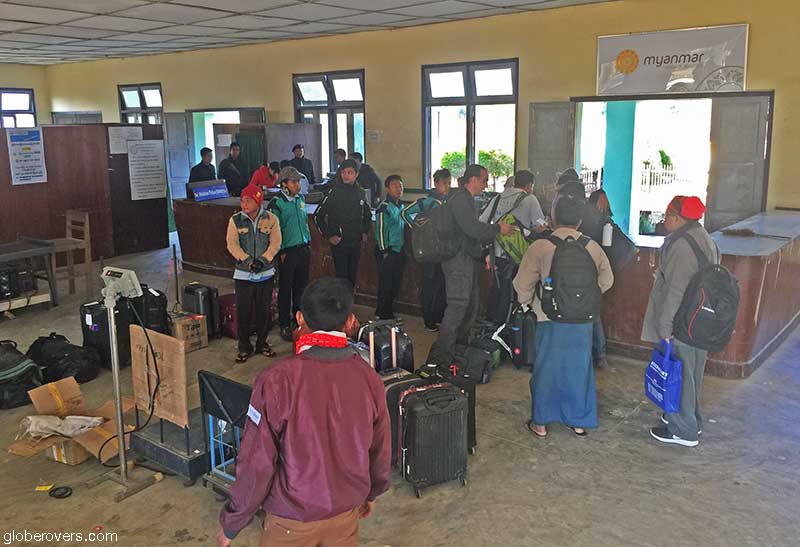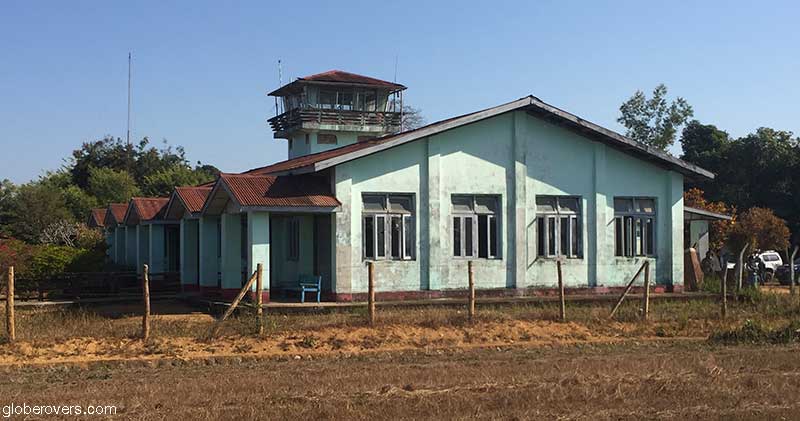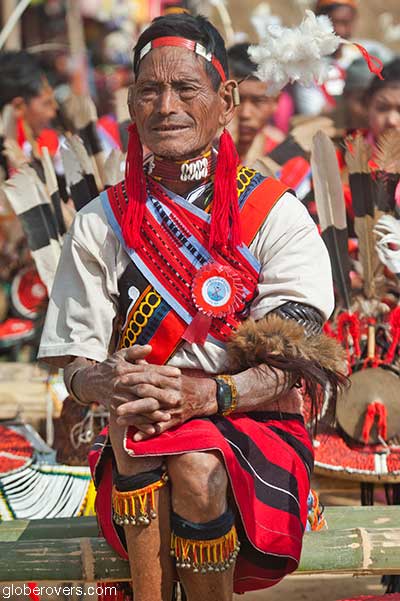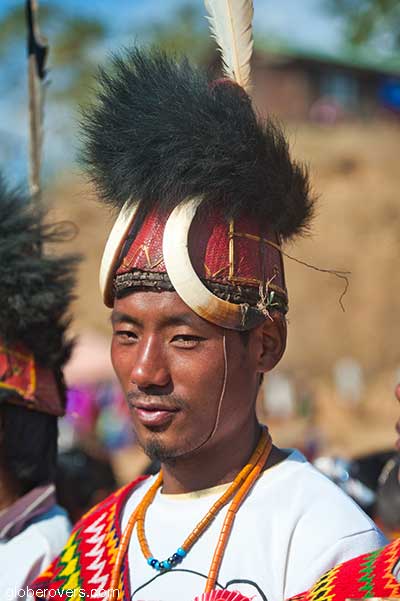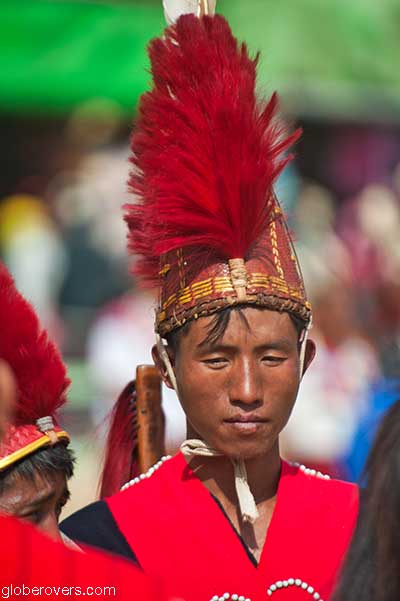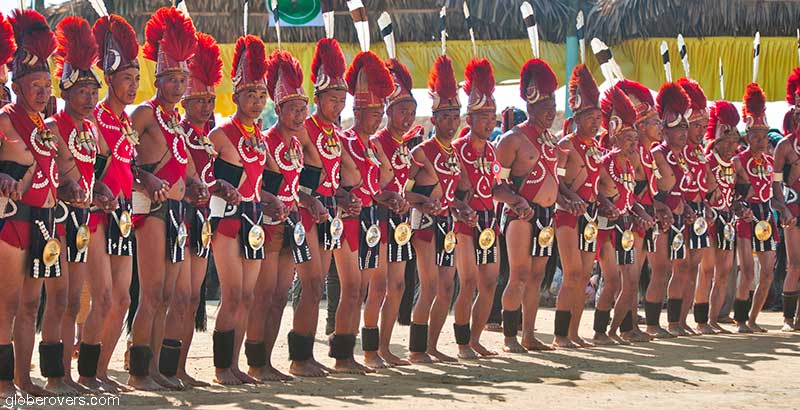
In the remote northwestern corner of Myanmar lies Nagaland—home to the Naga people who live peacefully on both sides of the border between India and Myanmar. During mid-January, the Naga people travel from far across the region to a chosen town where they spend three days celebrating the start of the new year. We joined them and were mesmerized.
Why travel to Nagaland?
- The low-down: If you want to attend a New Year festival of a very different kind and in a faraway place, then the Nagaland New Year Festival is for you.
- The brightest highlight: While the scenery is beautiful and the food is interesting, just watching the locals enjoying themselves on this very special day of the year is such a treat. All dressed up and as well-rehearsed as they can be under the circumstances.
- Intrepid destination: Absolutely an intrepid destination. While Nagaland is in quite a remote part, due to political instability it has been isolated from the outside world for many years.
- GlobeRovers Score (10 is highest): It is an interesting part of the world to visit, in particular to talk with the locals, often via an interpreter. The festival itself is colourful and offers many photo opportunities. What I did not like was having to travel on an organized tour, as I am totally allergic to that. I would much rather do the trip by myself on a motorbike or rent a car with driver as self-driving by foreigners is not allowed in Myanmar. I’ll score it a 7/10.
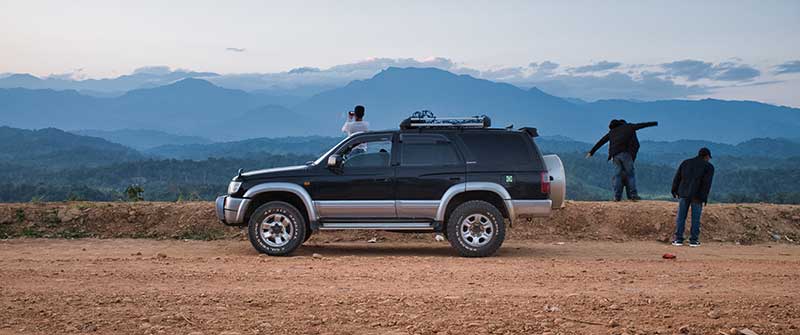
Table of Contents
Happy New Year!
New Year is the time of the year when most of us are in a festive mood. Wherever you are in the world, there is a special time of the year when your culture calls on you to reunite with friends and family, or alternatively to head for the beaches and party islands.
Nagaland New Year – A colourful 3-day festival in a remote part of Asia.
Some of us follow the Pope’s timing. That is Pope Gregory XIII who gave us the Gregorian calendar in 1582 so we know New Year starts at midnight on December 31st. Time to pop the champagne, or whatever you can get to feed your partying mood. Others look at the phase of the moon or the sun, or a combination of both.
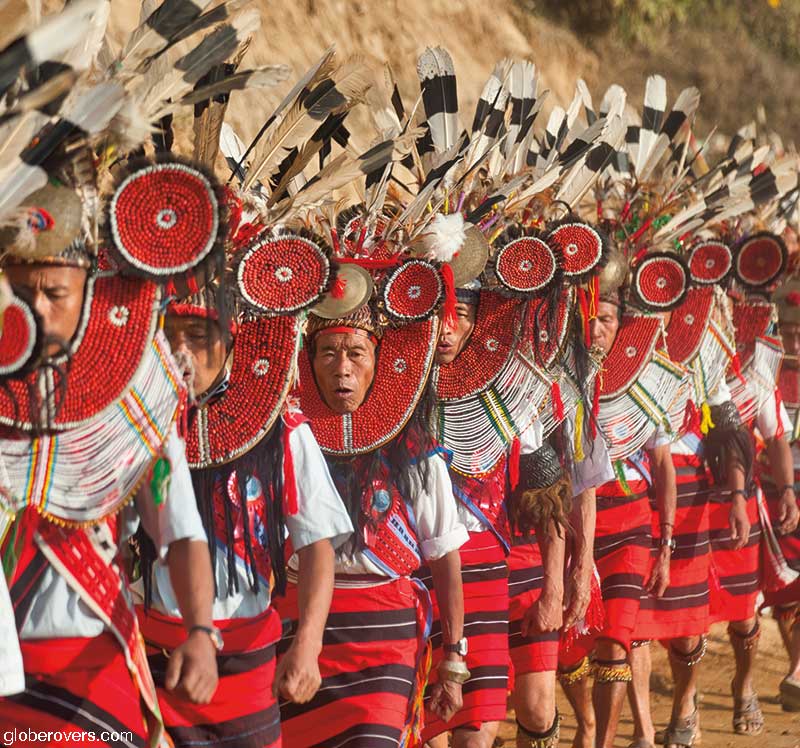
In Asia, several countries rely on the lunisolar calendar, an older version of the Hindu calendar. While the Chinese have a moving target around February, the Thai New Year (Songkran) is celebrated on April 13th.
New Year is a time to celebrate in dance and music. One of the most colourful festivals is in Myanmar’s Nagaland.
The Burmese New Year (Thingyan) is celebrated in the middle of April according to the Burmese lunisolar calendar. In Nagaland, the New Year festival is observed in mid-January.
Nagaland. That reminds me of a place with a very colourful New Year festival. I have been to some memorable New Year festivals in New York City’s Time Square, London, Hong Kong and Tokyo. I have attended countless Chinese New Year festivals filled with dancing lions and the accompanying banging of tanggu drums, cymbals, and gongs. But sadly, I had never experienced a Nagaland New Year festival.

Several times I have looked at the map of Nagaland, split between India and Myanmar (Burma) by an international dividing line, and wished I could visit.
Recently I decided to make it happen so I started my planning rituals. First I had to better understand the history of Nagaland and then decide whether to attend the Nagaland festival of India to the west of the international border or Myanmar’s Nagaland to the east.
Brief History of Nagaland
Without going into the deep history of the Naga people, let us start at the time of the arrival of the British East India Company in the early 19th century, followed by the British Raj—the ruling by the British of the Indian subcontinent from 1858 to 1947. The colonial interests in the land of the Naga people were mainly fuelled by their interest in the region’s oil and mineral resources, tea and timber, as well as to control the south-to-east Asian trade routes.
What once was a large united area populated by the Naga people, history left them divided between arbitrarily drawn political boundaries. First came the 1826 Treaty of Peace at Yandaboo, second the 1934 Pemberton Line, third the 1935 Government of Burma Act, and fourth the 1978 Indo-Burma Border Agreement, all of which disregarded the interests of the Naga people.
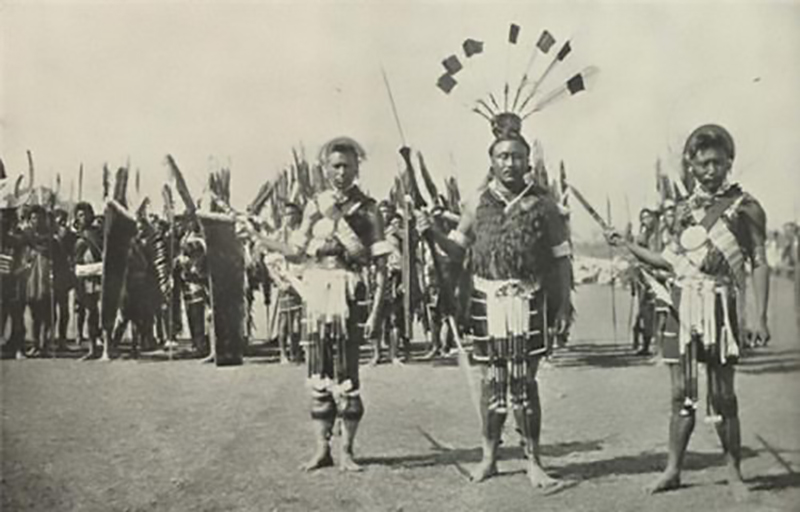
Let us first look at history on the India side of the divisive border.
From the time the first British arrived in 1832 until about 1852, several battles were fought with the defending local Naga tribes, particularly the Angami tribe known for their “head hunting” practices. After the bloody battle at Kikrüma where many died, the British decided to respect the Naga tribes by adopting a policy of non-interference. However, the tribes continued to assert their sovereignty by raiding the British forces, and hostilities continued in the Naga Hills well into the 1900s. By 1922 the British had fully integrated the Naga Hills into its “British India” and enforced the Indian rupee as the local currency. All these changes created profound social changes among the Naga people.
While loving the natural resources of the Naga people, the British regarded them as wild savage headhunters.
The Nagas have never considered themselves part of India. The day before India and Pakistan gained independence on August 14, 1947, Naga leaders declared their independence and named their land Nagaland, even though India asserted authority over their new country. Civil disobedience and an armed struggle began in 1955 with thousands of Indian troops battling the slings, bows and arrows of the Naga tribesmen. Many severed Indian heads ended up on display outside tribal homes as proof of their bravery—and the right to marry the women of their choice.
In their efforts to appease the Naga’s violent independence movement, in 1963 India declared Nagaland a self-governing state with restricted access by foreigners. However, violence continued and the ensuing five decades of conflict claimed about 200,000 Naga lives. Today the Naga occupy the Indian states of Assam, Arunachal Pradesh, Manipur, and the state of Nagaland. Fortunately, life is more peaceful on the India side and tourism is slowly growing.
The Naga people are spread across an area designated by the governments of India and Myanmar. An area that is significantly smaller than originally claimed by the Naga people.
Nagaland on the Myanmar side is a self-administered zone, as stipulated in the 2008 Constitution of Myanmar, and officially consists of three townships in the Sagaing Region: Lahe, Leshi, and Nanyun. The constitution grants this self-administered zone legislative powers over 10 areas of policy, including urban and rural development, road construction and maintenance, and public health. However, the “self-administered” status entails little meaningful autonomy as the national (Union) government still exercises power, even over issues such as when and where the New Year festival can be held.
The Myanmar military, the Tatmadaw, also maintains a presence here with its soldiers patrolling villages while carrying weapons, a constant reminder of the Union government and the military’s firm grip on the region. Large parts of land outside the official Nagaland are also claimed by the Naga but denied by the Myanmar government. The Naga people in the so-called Eastern Front, continue to struggle against the Myanmar government.
The Journey to Nagaland
To attend the Nagaland New Year Festival, I had to consider the logistics. For Nagaland in India, I could fly on Air India or IndiGo from Delhi or Kolkata to Nagaland’s Dimapur Airport. Alternatively, I could fly to Guwahati in Assam State and then take a 450 kilometres (280 mi) overnight bus to Nagaland.
Dimapur also has a railway station connected to the main network. From Kolkata, it is a 1,225 kilometres (761 mi) journey, and from Delhi almost twice the distance. None of the flights, trains, and bus options I considered appealed to me.
From what I read, the Nagaland New Year Festival on the Myanmar side of the border is similar to that on the India side: just as colourful with friendly people and good food. The difference is that the logistics of planning a visit was much easier.
An endless dirt road with no life in sight.
It is a long and lonely road to Nagaland.
Myanmar’s Nagaland festival is held around mid-January and rotates among the three towns of Lay Shi, Lahe, and Nanyun, in the large Sagaing Division of northwestern Myanmar. These townships are also among the poorest, most isolated, and least developed in all of Myanmar.
As the three towns are far apart, you need to plan accordingly. The distance between Nanyun in the far north and Lay Shi in the far south is over 200 kilometres (129 mi) as the crow flies. Driving over the mountains and along the rivers on the small and poorly maintained road can easily take two to three days.
The best way to reach Lay Shi is to fly from Mandalay to either Hkamti or Homalin and then drive. Homalin, to the south of Lay Shi, is the preferred airport as the driving distance is shorter than from Hkamti to the northeast of Lay Shi.
Of all three towns, Lahe lies the closest to an airport, Hkamti.
Nanyun, the northernmost town, is best reached by either flying from Mandalay or driving.
I attended the festival in 2019 when it was held in Lay Shi. As the shortest driving route was from Homalin, ProNiti Travel based in Yangon, booked our flight from Mandalay to Homalin on Myanmar National Airways. However, a few days before departure, we were told our seats had been given to government officials so we were unceremoniously bumped off. Fortunately, the travel agency found seats on the flight to Khamti, although that meant a much longer drive to Lay Shi.
The flight from Mandalay to Hkamti took one hour and fifteen minutes and the flight path took us over rolling hills, winding rivers, and remote villages.

On arrival at the tiny Hkamti airport, the few foreigners on board had to show their passports and details were noted down in the foreigner arrivals book. We collected our bags and off we went.


Airport arrivals hall
Outside the arrivals hall, our driver with his 4-wheel-drive vehicle was already waiting for us. After a brief stop at a nearby restaurant for an interesting lunch, our journey on the long rugged road to Lay Shi began. The road follows the scenic Chindwin River, with particularly good views about 8 kilometres (5 mi) before the village of Kaung Hein. This area has been described as “choking on gold” and is fouled with red sludge and soil, the ruins of abandoned mines and diggings.
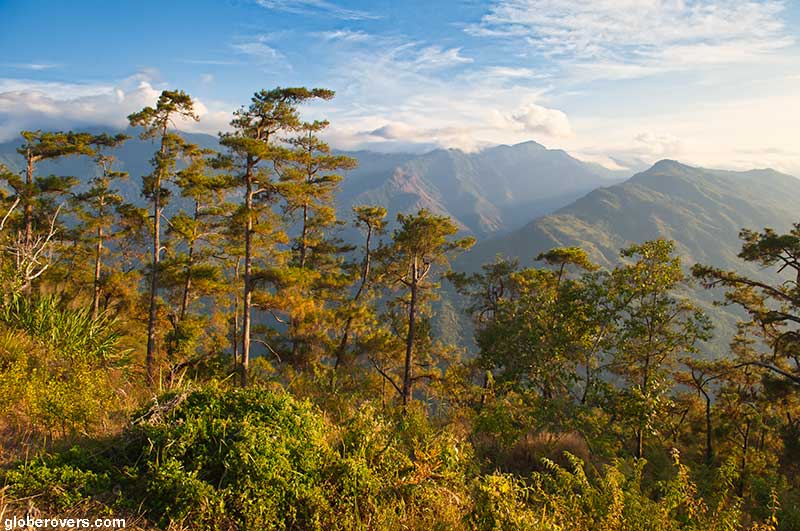
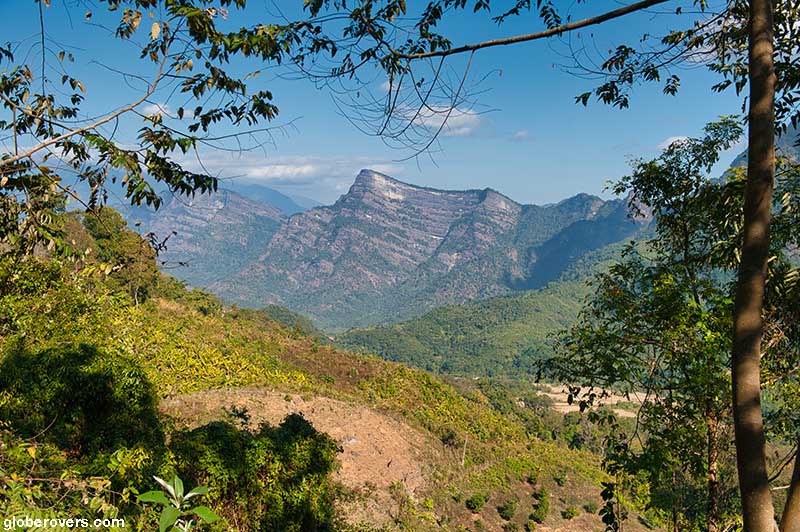
I truly got the feeling I was in a remote area when we saw no signs of life after almost two hours of driving. No vehicles on the road, no people, not even animals. This is not a national park or a protected area so I expected to see villages or at least people walking or cycling on the side of the road. When darkness fell, I hoped to see blinking eyes in the lights of our vehicle, but nothing.
According to our travel plan, the estimated three-hour 150 kilometres (93 mi) drive would bring us to Pint Mar village where a short ferry crossing over the Chindwin River would get us to Hta Man Thi. From here we had a further three-hour drive to Lay Shi. We thought the ferry closed at 8 pm, so we arrived at 7:30, only to be told that the last ferry crossing was at 6 pm.
Nearby, we found a very basic restaurant where we enjoyed a few beers and traditional food while pondering our next move. After lengthy conversations with locals in Burmese, our guide suggested we stay overnight in a private house across the street. “This is going to be fun,” I told my Italian friend. And fun it was! Six of us sleeping on thin blankets directly on the wooden floors of the second level of this traditional house. The floor was hard and the cold wind blew through the half-opened balcony door so I only got about three hours sleep.
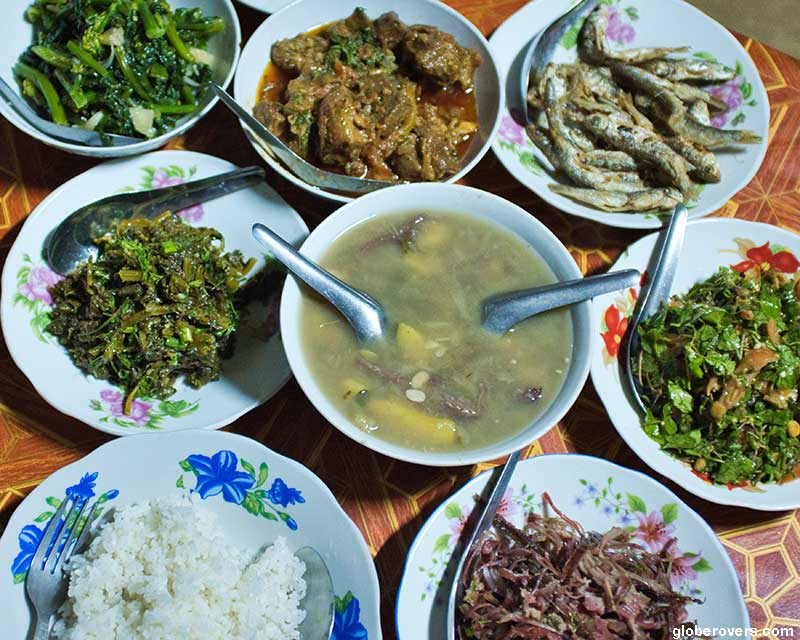
At sunrise, I was woken by the hosting grandmother while she prepared for her daily prayer ritual right next to where I was sleeping. After meticulously preparing the altar with her Buddhist offerings, she then locked into a 30-minute loud prayer while all my roommates were slowly getting up. I was quite relieved to get going but found that both my hips were badly bruised by the hard floor. It would be another six days before the pain was gone. I’m just not used to sleeping on the floor. But, it was all part of the adventure and I was enjoying every minute.
Pint Mar village, where we slept, was engulfed by fog at sunrise. I also saw a few places where people were burning dried leaves that created smoke. The combination of fog and smoke set an eerie scene over this small settlement by the river. I was happy to capture some fine photos of people strolling down the streets as the early morning sun struggled to break through the fog and smoke.
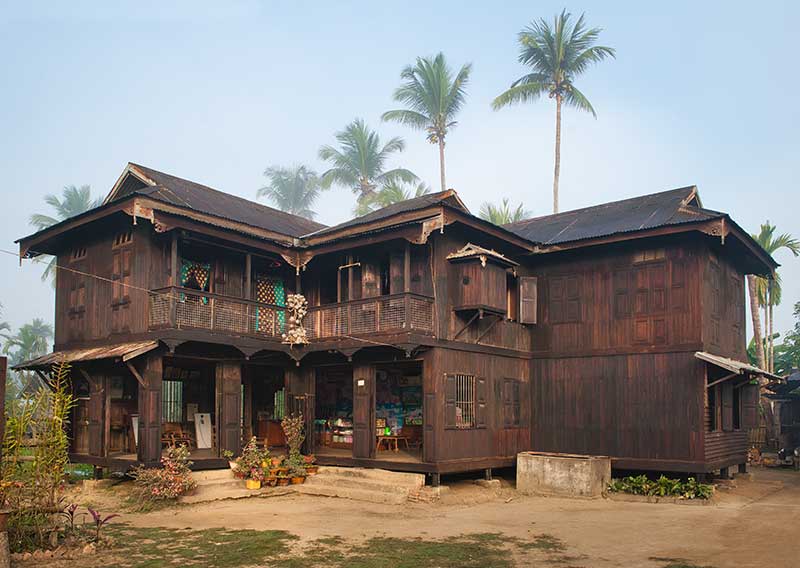
By the time we reached the wide flowing Chindwin River with the car ferry approaching our side, my camera was non-stop capturing the surreal scenery. After a short ferry ride with our vehicle onboard, we arrived at the steep banks on the other side where massive trees welcomed us to the village of Hta Man Thi. From here the winding road was very scenic in places.
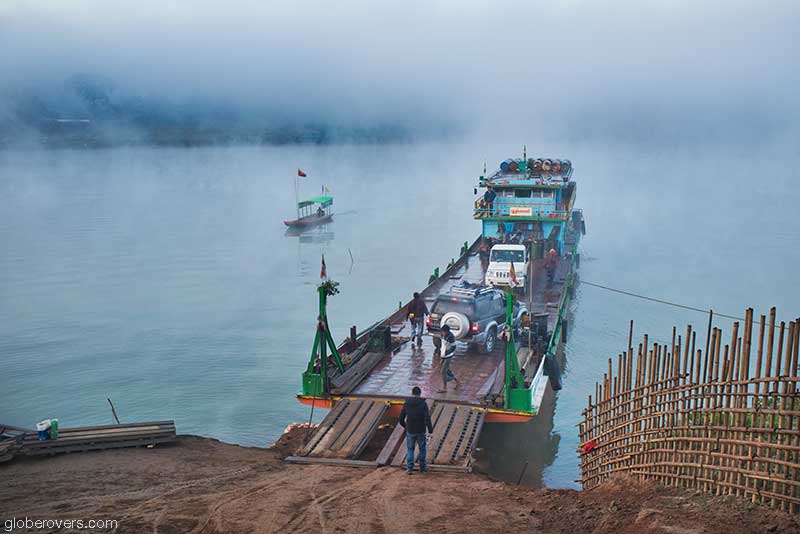

When we arrived on the perimeters of the Lay Shi township, a large banner flapping high over the small road welcomed us to the Nagaland New Year. The surrounding picturesque mountain scenery was my ultimate gift of the day. The views of Lay Shi as it stretched itself over the small hills were beautiful.
“Welcome to Nagaland”, our guide proclaimed. And Nagaland it sure was: Remote, beautiful, peaceful, and so ready for the Nagaland New Year Festival. At last, we made it.
The Naga People
I firmly believe that before you party with people, you should first get to know them. Besides the fact that partying with friends is safer than partying with strangers, you also will enjoy a party more if you first try to understand the people, their culture, their lifestyles, and what excites them about the upcoming party. With this in mind, I had read a lot about the Naga people and their struggles before arriving in town. Now it was time to meet the real Naga people.
The Naga people are a group of tribes historically known as fierce warriors who displayed the heads of their enemies at the front of their homes.
To study the Naga people, let’s first look at how they fit into Myanmar’s administrative structure.
Myanmar is divided into regions (previously called “divisions”), states, union territories, as well as self-administered zones and self-administered divisions. The regions are ethnically predominantly Bamar but often mixed with several other ethnic groups, such as in Yangon and Mandalay. The states and the zones are dominated by specific ethnic minorities, such as Shan State for the Shan people and Kayah State for the Kayah people.
Nagaland lies in the Sagaing Division which means it is home to several ethnic groups without being dominated by a single group. Sagaing has sizeable groups such as the Bamar, Shan, Naga, and Zomi, as well as smaller numbers of Kadu and Ganang. Each group tends to cluster together.
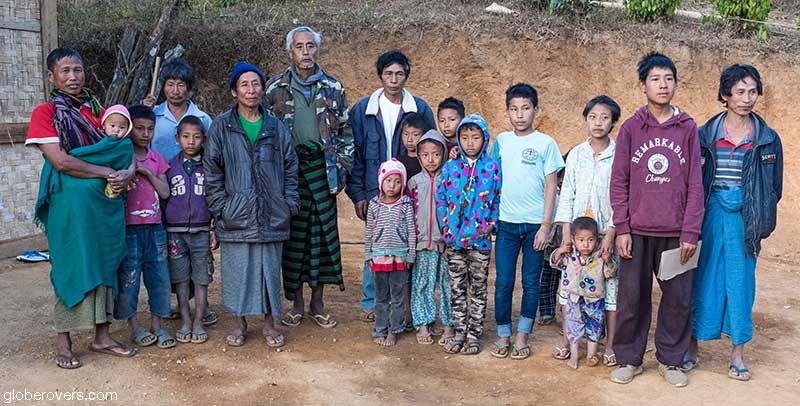
“Naga” is a collective noun to describe the many sub-tribes living in an area on the border between India and Myanmar. The most prominent Naga tribes are the Angami, Ao, Chakhesang, Chang, Khiamniungan, Konyak, Lotha, Mao, Maram Naga, Phom, Pochury, Poumai, Rengma, Rongmei, Sangtam, Sumi, Tangkhul, Thangal, Yimchunger and the Zeliang. With so many tribes who were isolated centuries ago meeting only in battle to claim each others’ severed heads, a distinct language is bound to have developed for some or each of these groups.
Today the Nagas speak various distinct Tibeto-Burman languages, including Anāl, Angami, Ao, Chakhesang, Chang, Lotha, Mao (Emela), Maram, Phom, Pochuri, Poumai (Poula), Phom, Rengma, Rongmei (Ruangmei), Sangtam, Sumi, Tangkhul, Thangal and Zeme.
With so many distinct languages people often can’t understand each other, so the Naga people created their own common language called Nagamese, an Assamese-, Hindi- and Bengali-lexified creole language. While widely spoken in western Nagaland (India), the Naga Tradition, Culture and Literature Committee Central (NTCLCC) is working enthusiastically to teach the Nagamese language to the Naga people of eastern Nagaland (Myanmar). Where we were in the Sagaing Division, there are no less than 16 or 17 “officially recognised” Naga tribes.
The Angami sub-tribe buries their men with a live young chicken, a fire stick, and one or two spears.
Estimates of the Naga population vary, but by most accounts there are about 1,850,000 Nagas living on the Indian side of the border. On the Myanmar side, the population is about 150,000 of which about 120,000 live inside the “Naga Self-Administered Zone”, announced by decree on 20 August 2010 as per the 2008 Constitution of Myanmar. The remaining Nagas live outside the boundaries of this self-administered zone.
About two-thirds of the Nagas are Christian, mainly Baptist, while the rest practice Theravada Buddhism. Christianity has come a long way for the Nagas. Since the mid-19th century, Christian missionaries from the United States and Europe were posted to India and then spread to Nagaland where they converted the Naga tribes from animism to Christianity. Apparently, the missionaries found a very receptive audience and the conversion process progressed relatively quickly.
Today the Baptists have their own little churches. At the age of twenty, their children can decide if they want to be baptised. After a few weeks of preparations, they are often baptised in the nearby river. Once married, the bride normally moves in with the groom’s family where an extension to the current house is built for the newlyweds. While Baptists normally marry within their religion, they are allowed to marry an animist if the animist converts to Baptism.
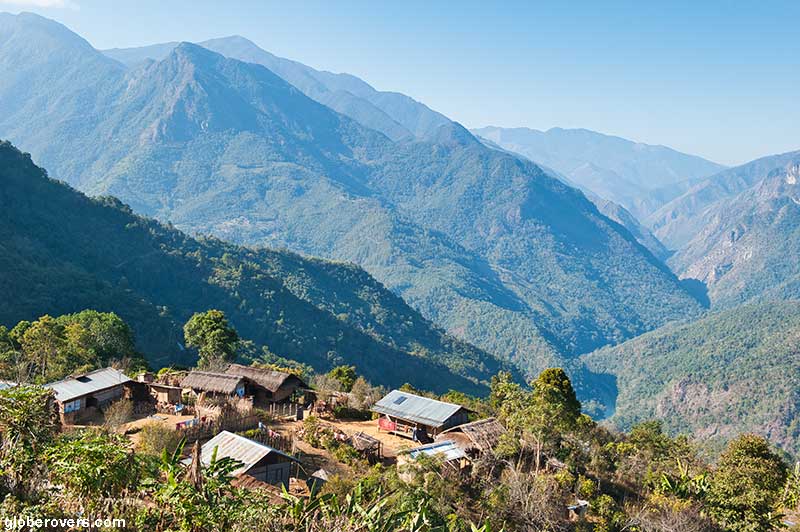
There are small Naga villages of different tribes in all directions of Lay Shi. These tribes are expert craftsmen and that is evident in the ways they construct their huts. A common practice among some tribes is to decorate the entrances of their huts with the heads of buffaloes, which has replaced the human heads these headhunters historically showcased.
We spent two half-days driving in different directions from town to visit a few of these villages and were warmly welcomed by the people. On arrival, we were first spotted by barking dogs, then chickens, kids, and finally a few adults would come to greet us. During the daytime it is only the elderly and kids in the villages as the working people, generally aged 12 to 60, are active in the fields and hills.
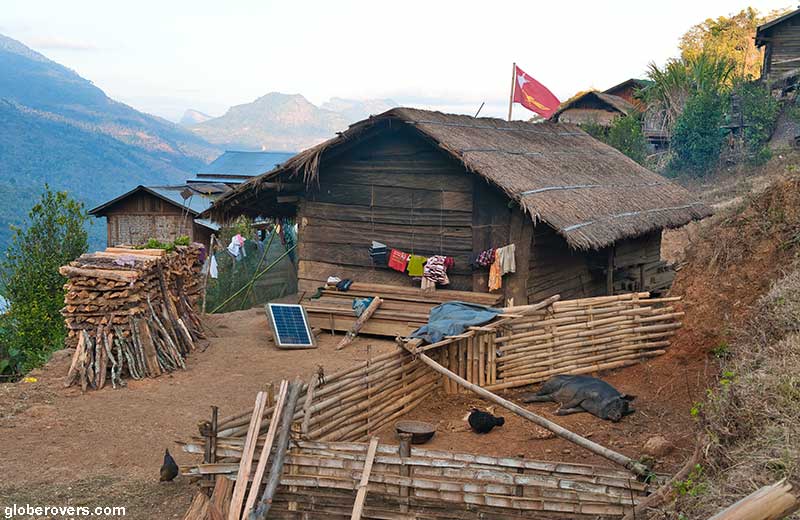
These people practice slash-and-burn cultivation and mainly grow rice, corn, maize, yams, and beans. Sadly, this way of farming leaves the rolling hills barren that once were covered in primary forests. Farmers grow crops for two to three years in an area and then move to another area to allow the soil about ten years to recover. This means that the slashing-and-burning continues relentlessly which decimates the natural forests.
As per their ancient traditions, Naga men enjoy hunting and fishing while the women collect edible leaves and cultivate the fields.
An ancient tradition that fortunately died out, as far as we know, is the practice by men of bringing home a severed head from another village and hanging it outside his house—a requirement before the in-laws would allow him to take his new bride. Nowadays Naga men prefer to visit a nearby town, such as Lay Shi, to trade or sell their produce, crafts, or livestock in exchange for items needed by the family.
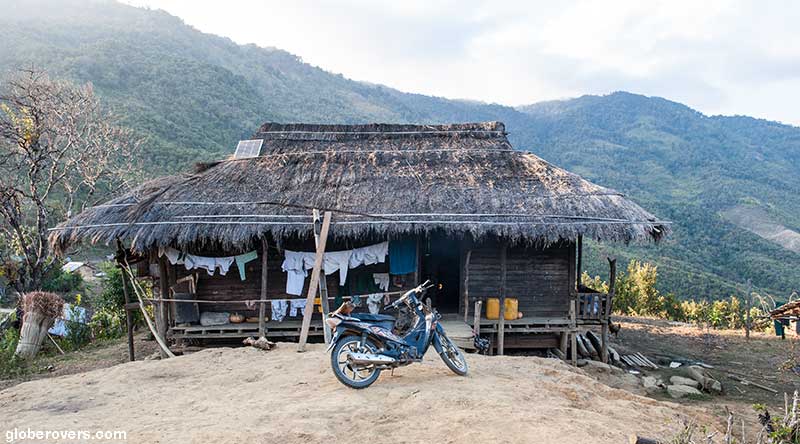
Increasingly their cultural practices are changing. In the old days, Naga men wore loincloths and decorated themselves with animal parts such as tusks and tiger teeth. The younger generation is nowadays more likely to wear jeans and “I love New York” t-shirts rather than the traditional loincloths which they only wear when participating in festivals.
While most Naga communities remain impoverished and inaccessible by road, the Nagas are renowned for their proud sense of independence, integrity and community spirit.
At one village we were warmly invited by the elders into a home which seemed to be used as their community social room. Through our interpreter, I asked several questions about their lives, such as their water supply, medicines which they gather from nature, their farming, kids, schooling, religion, and more. Once I was done with my questioning, an elder asked me: “As you have visited many countries around the world, how do we compare? Are we very poor?”
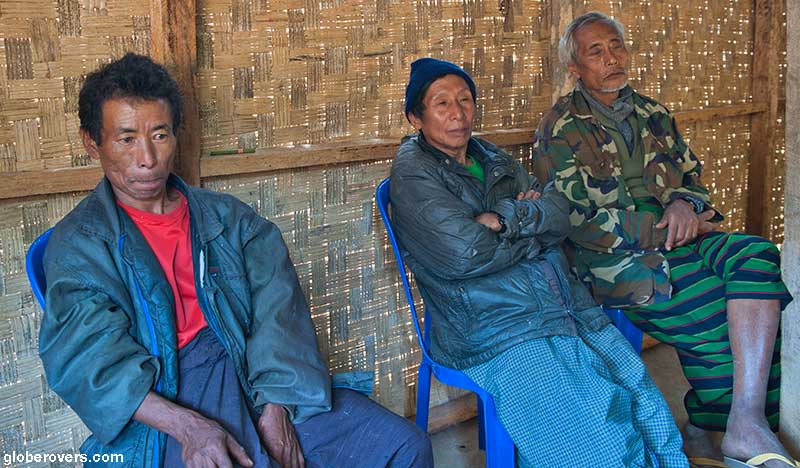
While there was a straight answer, I replied that there are many poor people around the world and most do not have clean water, fresh air, and sufficient food and shelter. The Naga people are blessed to live in their own homes with ample space where their kids can safely play around. They have access to fresh water from the mountains, clean air, and fresh food is grown on their own land. The elders all listened attentively to my interpreter and the moment he finished they broadly smiled and started to clap their hands.
I knew that I hit a soft spot in their minds so deep in my heart I was shedding a tear. They then thanked me for saying what I just said, and offered me a bag of their local oranges and a big cheroot, a locally rolled cigar, which I politely declined.
The time spent with these people was time spent very well. I now have a better understanding and appreciation for the way they live.
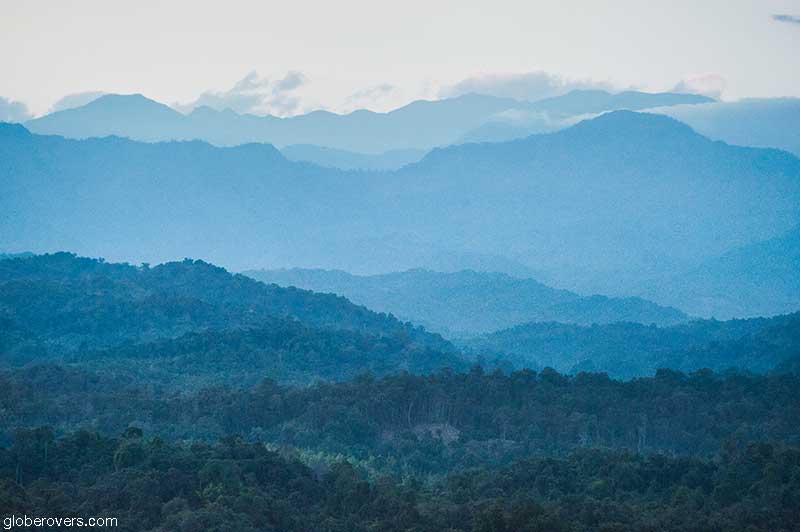
The Nagaland New Year Festival
All Naga people are linked by some common customs, their Nagamese language, and their celebration of the Naga New Year.
Held in winter when the harvesting is done and before the new planting season starts in full swing, it is a time to take a rest while reuniting with the extended family and friends from near and far away. It is a time to settle debts and make prayers for great yields in the upcoming season. It has been reported that during the festival, the Nagas pay respect to their deities by scarifying domestic animals, something which I personally did not witness.
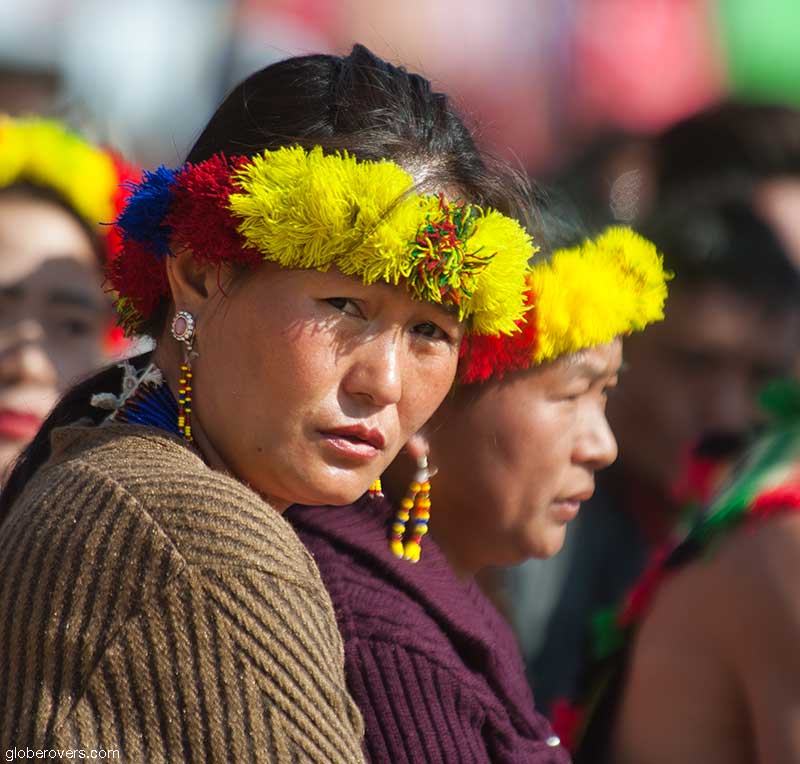
In the distant past, these celebrations were not coordinated among the villages so the dates varied, and every village tried to have their own celebration in its own way. In the early 1990s, a commission decided to fix the date to January 15th, even though celebrations are allowed to start two days earlier. It was also then decided to rotate the celebration party through three different towns in Myanmar’s Nagaland: Lay Shi, Lahe, and Nanyun. The local governments now also commit money and manpower to make the annual festival a big and successful celebration. It is not clear to me how much money is given by which levels of governments, and exactly where the money goes.
The festival I attended in Lay Shi was very well organised—kudos to the organising committee. It is officially a two-day festival with the first day set aside for rehearsing of the traditional dances. Each of the seventeen groups, that included the Makury tribe from Phüvjüv village, as well as the Mëkheotjüv, Tangkhul, Para and Konyak tribes, got a few rounds to showcase their best synchronised and chanting manoeuvres in front of a clamouring throng of spectators.
Singing folk songs while dancing in large circles is an essential ingredient of their traditional culture as it is through singing that folk tales are kept alive. Their songs are both romantic and of historical significance as they narrate stories of famous ancestors and important incidents. Some songs are seasonal, such as harvest songs, and describe the various activities performed in that particular season.
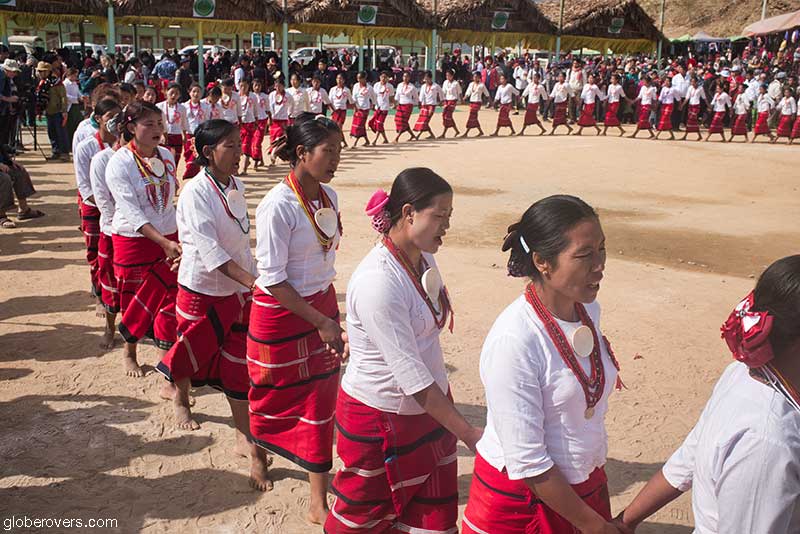
The warm-up dances and singing continued into the evening followed by a few local and national singers and bands performing on a stage. Well attended and much liked by the local audience, it became way too cold for us and we went back to our hotel. Later in the evening while we were sitting around a small bonfire outside our hotel, a large group of male dancers surprised us with their spectacular dancing and singing performance around the fire.
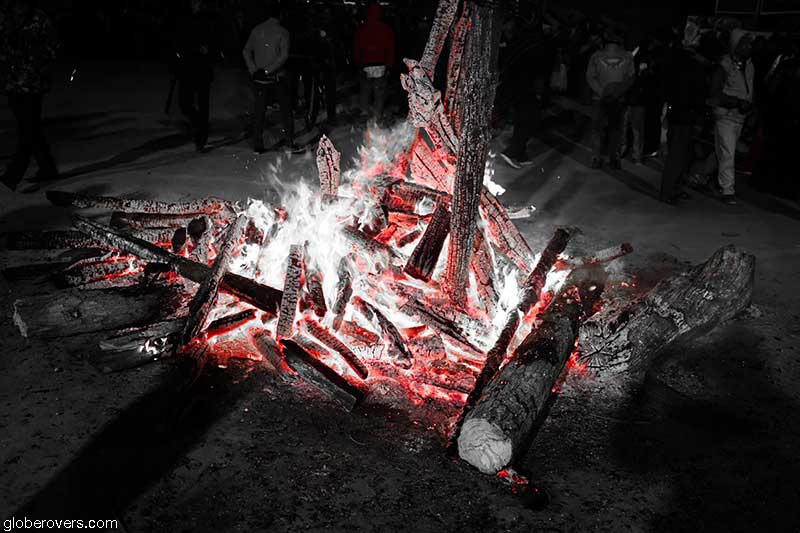
The official opening of the festival happened around 8:30 the next morning by officials who arrived the previous day by helicopter—to the great astonishment of the locals. The rest of the day was filled with each dance group performing a few dances.
Lunch was a special event as the organisers had a big free lunch prepared for all attendees—spectators and performers. Food consisted of rice and meat served on banana leaves. It was indeed a special moment to see these people humbly accepting and enjoying the food, and for me, a highlight of the entire festival.

There were also a few sporting events during the day such as team wrestling, tug of war, and an incredible impromptu performance by a group beating the slit drum carved from a large log. This is technically not a drum but an idiophone as the sound is primarily created by the whole log vibrating without the use of a membrane.

The day’s festivities on the town’s central football field concluded with dance performances by each group around a large bonfire in the middle of the field. This was followed by spectators joining the dancers around the fire and eventually a spectacular fireworks display.
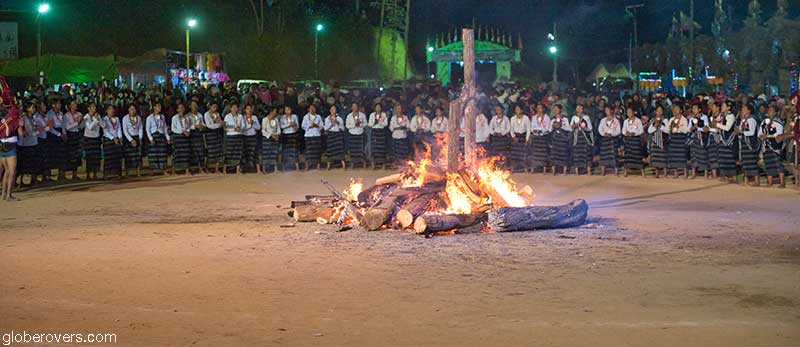
The entire festival had a very friendly party atmosphere. Performers and local audiences were all happy to pose for photos while the photographers had a field day. Some foreigners were equipped with seriously long lenses and big cameras while others were snapping away on their smartphones. We were all impressed with the colourful outfits, facial decorations, and elaborate headdresses of the performers.
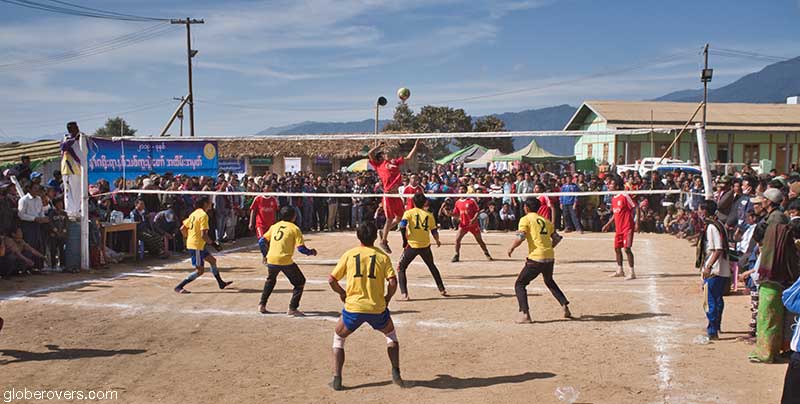
While the attire for the performances varies by group, there were some commonalities. Men generally were bare-chested wearing black or red shawls with a matching kilt or very short pants or underwear. Some groups’ headgear and shawls were embroidered with cowrie shells. The cowrie decoration is quite popular among the Naga people and apparently the cowries are always sewn by the man wearing the cloth and never by his wife or anybody else.
The men are known as warriors and their ceremonial headgear is a symbol of position, status and also power. Headgear is inherited by each warrior and worn after having earned an achievement. Each group’s headgear is distinctive, made of cane and bamboo and then elaborately decorated with dyed goat fur, bird feathers, hornbill beaks, boar tusks, parts of animal skulls, and anything symbolic of the warrior’s bravery as a headhunter.
Rare items such as hornbill beaks and feathers as well as certain rare animal parts are worn like medals of the wearer’s achievements. Headgear is particularly important to the group leader as it must strongly symbolise power and authority.
Another reason why the headgear is so highly regarded is that the Moi, or spiritual part of the deceased, lives in the headgear. While I have not verified this fact, it has been reported that according to Naga belief, the human soul is divided into the Yaha (the animal aspect) and Moi (the spiritual aspect). When a Naga person dies, the Yaha travels to the land of the dead while the Moi remains in the village and often takes to the headgear of the warriors. An abundance of Moi is considered beneficial to the prosperity and fertility of the tribe.
The women mostly wear plain black, blue, green, red and white blouses and skirts with coloured bands. Most wear elaborate necklaces and armbands.
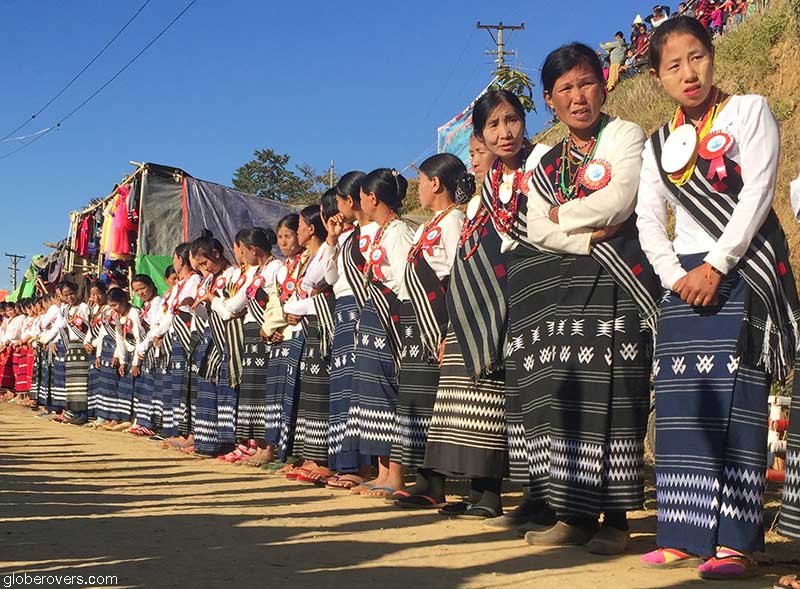
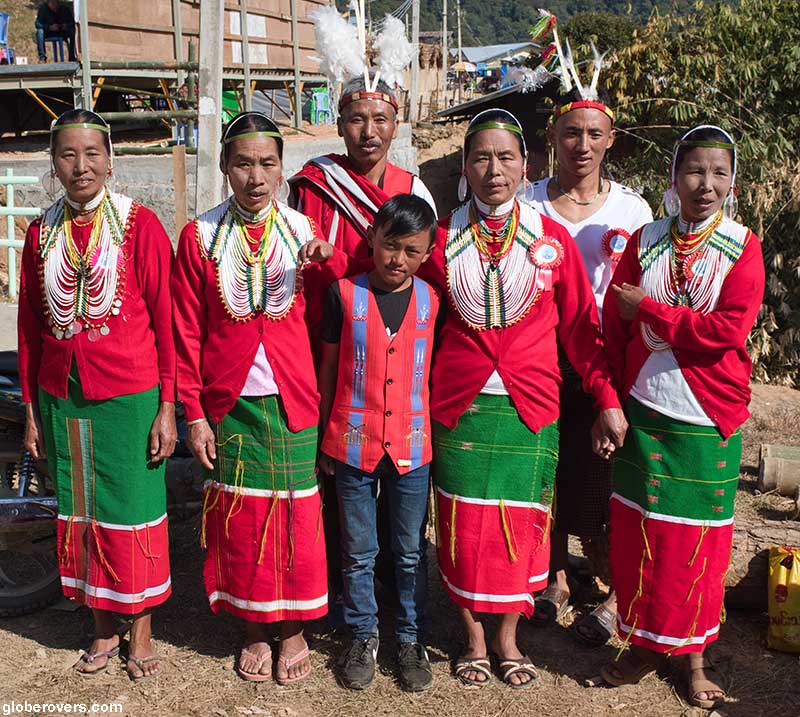
According to a local printnews report, the 2019 Naga New Year Festival was attended by 49 foreign travellers. The report did not state how many locals attended, but mentioned that “33 men and 16 women from countries such as Germany, Belgium, Switzerland, Japan, Australia, France, Israel, the US, Canada, Czech Republic, Italy, South Korea, and Spain joined the Naga New Year Festival”.
According to records of the Sagaing Region’s Department of Immigration and Population, the number of tourists to Leshi Township totalled 7 in 2011, 37 in 2012, 21 in 2013, 19 in 2014, 59 in 2015, 39 in 2017, and 63 in 2018.”
After the fireworks, we all felt half-frozen. January is mid-winter and this part of Myanmar can get quite cold. We were glad to arrive at our hotel and get to bed.

The Return Journey
After spending three days with the Naga people, it was time to return to Hkamti for our flight back to Mandalay. The drive back was uneventful and we made sure to cross the river during the daytime. Back in Hkamti we had time to quickly explore the town before flying back to Mandalay the next morning.
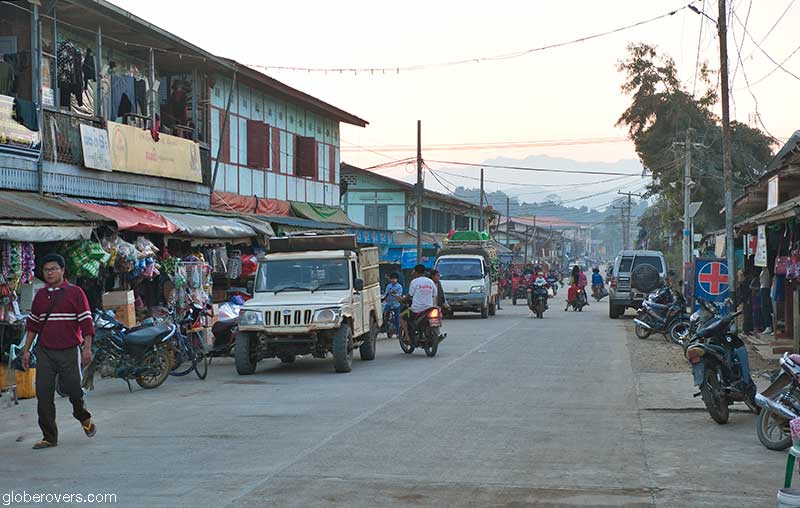
Hkamti is a rugged town and somehow made me think of a typical lone-star American midwest town of the 1960s. As we walked through the dusty streets filled with Kodak-moments around every corner, we were looking for something that we all expect in a lone-star town. Just as we turned northwards along the muddy shores of the Chindwin River, we saw it…
Large green, red and white signboards announced our arrival at the “Beer Boy” bar and restaurant. This dimly-lit social hangout with metal tables and chairs is known for its cold “Myanmar Beer”, the best selling brand of beer in a country where choices are limited. As we sat down, we received a plate of peanuts and a small serving of the famous Burmese tea-leaf salad. On the house and repeatedly refilled, this was just the place to be.
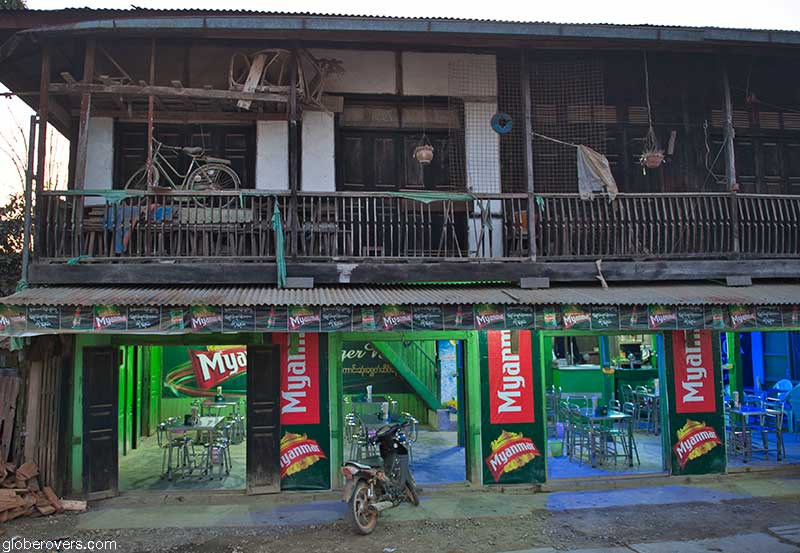
Hkamti treated us well with many photos, friendly people, interesting food, and of course the cold beer. The hotel stay was uneventful but we all had a well-deserved rest. After breakfast the next morning it was time to head for the nearby airport and fly back to Mandalay, from where we all went home into different directions.
☛ Read more: Hill Tribes of Myanmar’s Shan State
☛ Read more: Portraits of Nagaland – Myanmar
I was glad that at last I had visited Nagaland, in particular, to join in with the New Years festival. It sure was an interesting way to celebrate New Year and a trip that I won’t easily forget. I hope you make it to Nagaland one day and get to take part in their festivals.
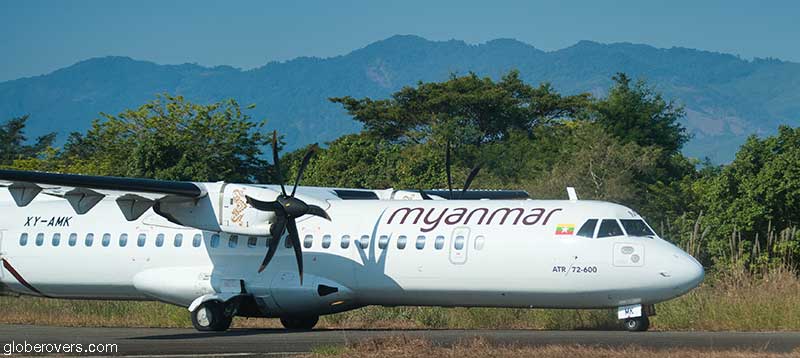
This tour was partially sponsored by ProNiti Travel in Yangon.
Contact them at sales@pronititravel.com to book your tour to Nagaland.

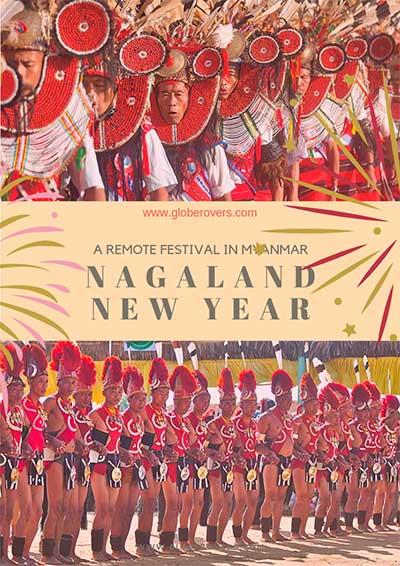
Further reading
- Hill Tribes of Myanmar’s Shan State (by GlobeRovers)
- Myeik (Mergui) Archipelago – A Paradise (by GlobeRovers)
- The Mojo Of Nagaland Culture
- Ministry of Hotels & Tourism Myanmar

Blog post and photos by Peter who has been travelling almost full-time since 2005 and has been to over 122 countries. He visited several countries, such as Japan, more than 20 times. Peter is Editor-in-Chief and Publisher of GlobeRovers Magazine, an independent travel magazine focused on intrepid destinations.

